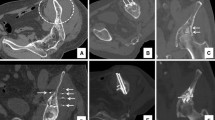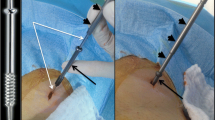Abstract
Objective
To evaluate the feasibility and effectiveness of computed tomography (CT)-guided percutaneous screw fixation plus cementoplasty (PSFPC), for either treatment of painful metastatic fractures or prevention of pathological fractures, in patients who are not candidates for surgical stabilization.
Materials and methods
Twenty-seven patients with 34 metastatic bone lesions underwent CT-guided PSFPC. Bone metastases were located in the vertebral column, femur, and pelvis. The primary end point was the evaluation of feasibility and complications of the procedure, in addition to the length of hospital stay. Pain severity was estimated before treatment and 1 and 6 months after the procedure using the visual analog scale (VAS). Functional outcome was assessed by improved patient walking ability.
Results
All sessions were completed and well tolerated. There were no complications related to either incorrect positioning of the screws during bone fixation or leakage of cement. All patients were able to walk within 6 h after the procedure and the average length of hospital stay was 2 days. The mean VAS score decreased from 7.1 (range, 4–9) before treatment to 1.6 (range, 0–6), 1 month after treatment, and to 1.4 (range 0–6) 6 months after treatment. Neither loosening of the screws nor additional bone fractures occurred during a median follow-up of 6 months.
Conclusions
Our results suggest that PSFPC might be a safe and effective procedure that allows the stabilization of the fracture and the prevention of pathological fractures with significant pain relief and good recovery of walking ability, although further studies are required to confirm this preliminary experience.



Similar content being viewed by others
References
Janjan N. Bone metastases: approaches to management. Semin Oncol. 2001;28:28–34.
Ward WG, Holsenbeck S, Dorey FJ, et al. Metastatic disease of the femur: surgical treatment. Clin Orthop Relat Res. 2003;415(Suppl):S230–44.
Popken F, Schmidt J, Oegur H, et al. Treatment outcome after surgical management of osseous breast carcinoma metastases. Preventive stabilization vs. management after pathological fracture. Unfallchirurg. 2002;105(4):338–43.
Ristevski B, Jenkinson RJ, Stephen DJ, et al. Mortality and complications following stabilization of femoral metastatic lesions: a population-based study of regional variation and outcome. Can J Surg. 2009;52(4):302–8.
Anselmetti GC, Manca A, et al. Treatment of extraspinal painful bone metastases with percutaneous cementoplasty: a prospective study of 50 patients. Cardiovasc Intervent Radiol. 2008;31:1165–73.
Botton E. Cementoplasty for painful bone metastases: a series of 42 cases. Med Oncol. 2012;29:1378–83.
Cotten A, Dewatre F, Cortet B, et al. Percutaneous vertebroplasty for osteolytic metastases and myeloma: effects of the percentage of lesion filling and the leakage of methyl methacrylate at clinical followup. Radiology. 1996;200:525–30.
Schep NW, Heintjes RJ, Martens EP, et al. Retrospective analysis of factors influencing the operative result after Percutaneous osteosynthesis of intracapsular femoral neck fractures. Injury. 2004;35(10):1003–9.
Phan K, Rao PJ, Mobbs RJ. Percutaneous versus open pedicle screw fixation for treatment of thoracolumbar fractures: systematic review and meta-analysis of comparative studies. Clin Neurol Neurosurg. 2015;135:85–92.
Trumm CG, Rubenbauer B, Piltz S, Reiser MF, Hoffmann RT. Screw placement and osteoplasty under computed tomographic-fluoroscopic guidance in a case of advanced metastatic destruction of the iliosacral joint. Cardiovasc Intervent Radiol. 2011;34[Suppl 2]:S288–93.
Tan JW, Shen BH, DU W, Liu JQ, Lu SQ. Bone cement enhanced pedicle screw fixation combined with vertebroplasty for elderly patients with malignant spinal tumors. Chin Med J (Engl). 2013;126(13):2495–8.
Clarençon F, Jean B, Pham HP, et al. Value of percutaneous radiofrequency ablation with or without percutaneous vertebroplasty for pain relief and functional recovery in painful bone metastases. Skeletal Radiol. 2013;42:25–36.
Chapman CR, Case KI, Dubner R, et al. Pain measurement: an update. Pain. 1985;22:1–31.
Deschamps F, Farouil G, Hakime A, Teriitehau C, Barah A, de Baere T. Percutaneous stabilization of impending pathological fracture of the proximal femur. Cardiovasc Intervent Radiol. 2012;35(6):1428–32.
Weill A, Chiras J, Simon JM, Rose M, Sola-Martinez T, Enkaoua E. Spinal metastases: indications for and results of percutaneous injection of acrylic surgical cement. Radiology. 1996;199:241–7.
Cazzato RL, Koch G, Buy X, et al. Percutaneous image guided screw fixation of bone lesions in cancer patients: double centre analysis of outcomes including local evolution on the treated focus. Cardiovasc Intervent Radiol. 2016;39(10):1455–63.
Author information
Authors and Affiliations
Corresponding author
Ethics declarations
Conflicts of interest
The authors declare that the research was conducted in the absence of any commercial or financial relationships that could be construed as a potential conflict of interest.
Ethical approval
All procedures performed in studies involving human participants were in accordance with the ethical standards of the institutional and/or national research committee and with the 1964 Declaration of Helsinki and its later amendments or comparable ethical standards.
Informed consent
Informed consent was obtained from all individual participants included in the study.
Rights and permissions
About this article
Cite this article
Pusceddu, C., Fancellu, A., Ballicu, N. et al. CT-guided percutaneous screw fixation plus cementoplasty in the treatment of painful bone metastases with fractures or a high risk of pathological fracture. Skeletal Radiol 46, 539–545 (2017). https://doi.org/10.1007/s00256-017-2584-y
Received:
Revised:
Accepted:
Published:
Issue Date:
DOI: https://doi.org/10.1007/s00256-017-2584-y




